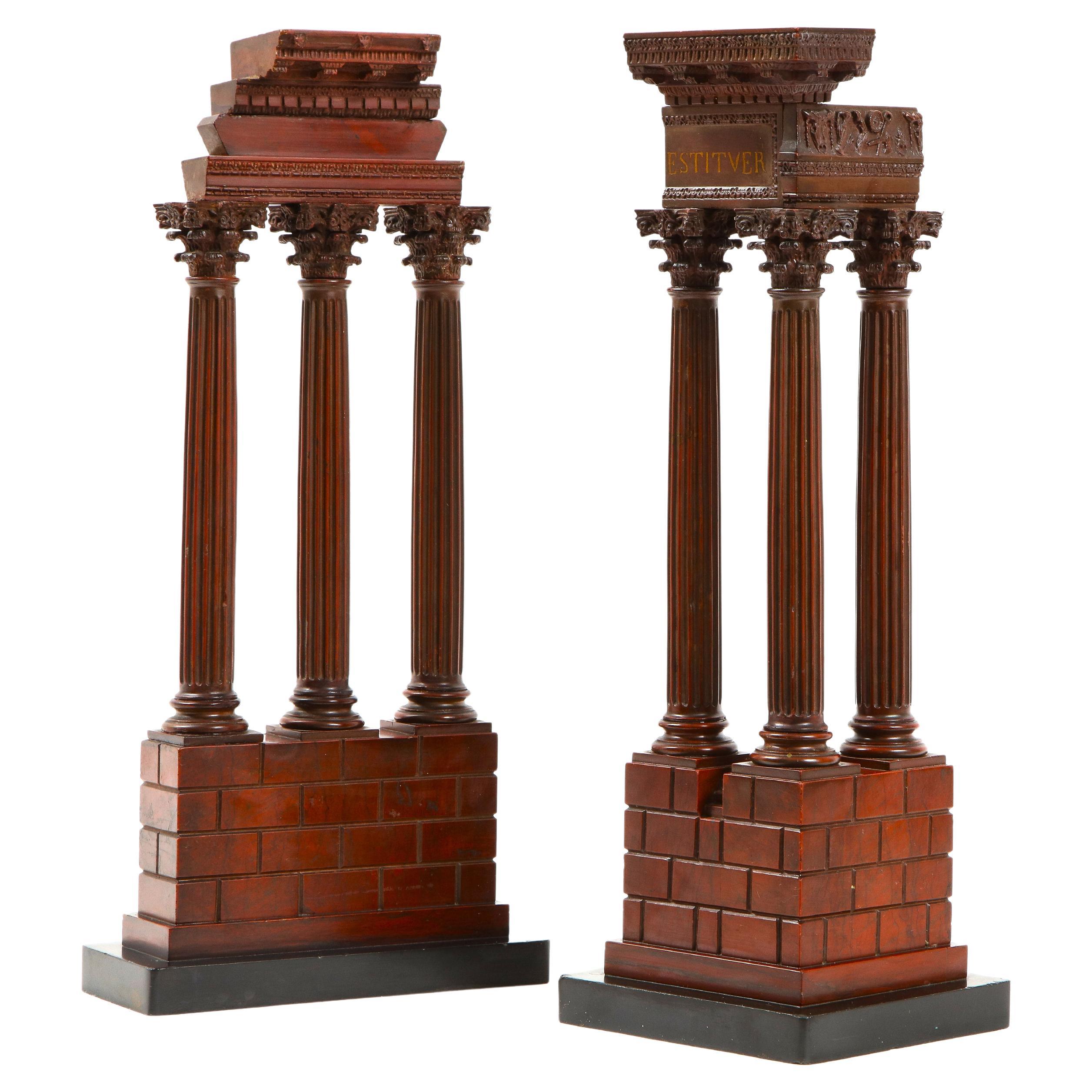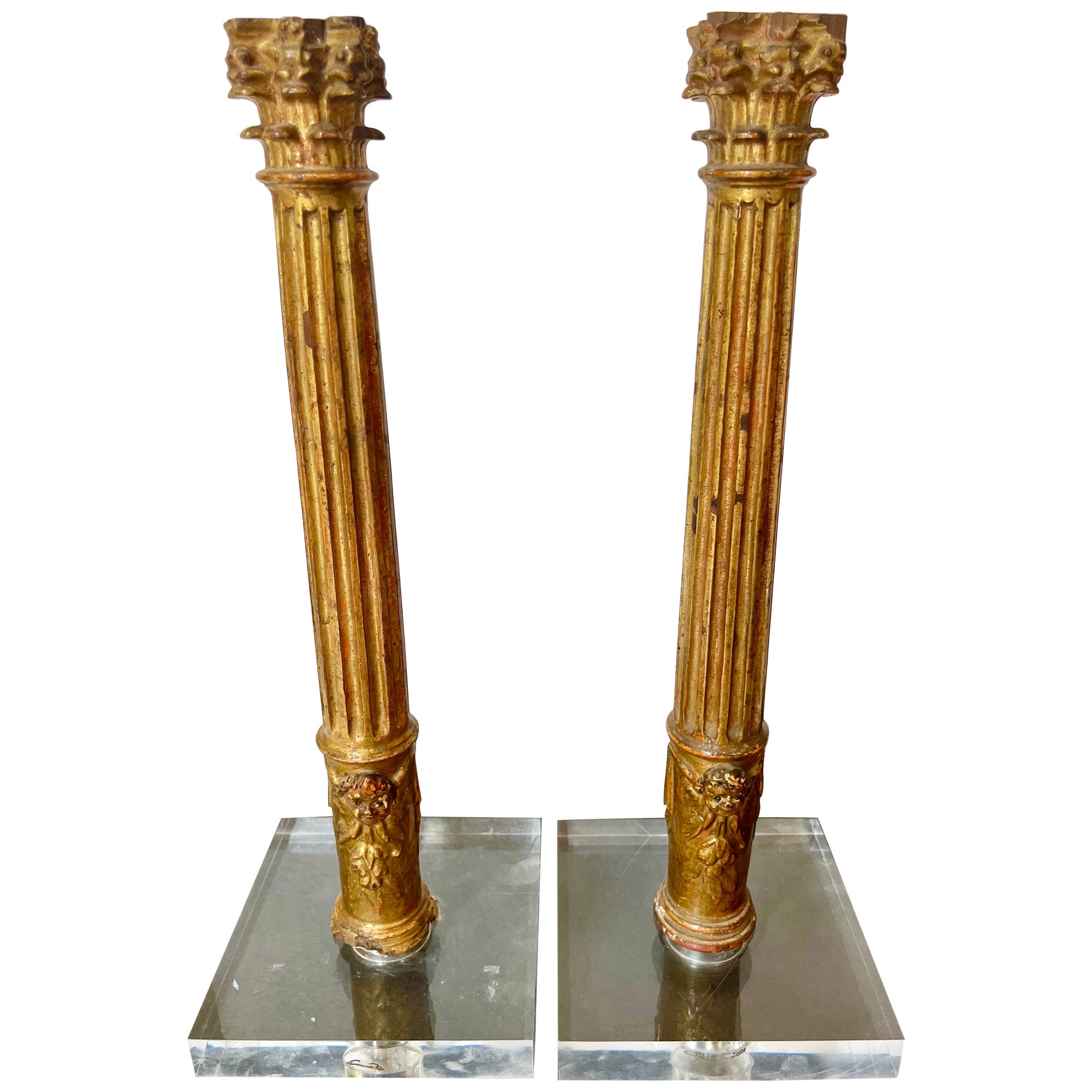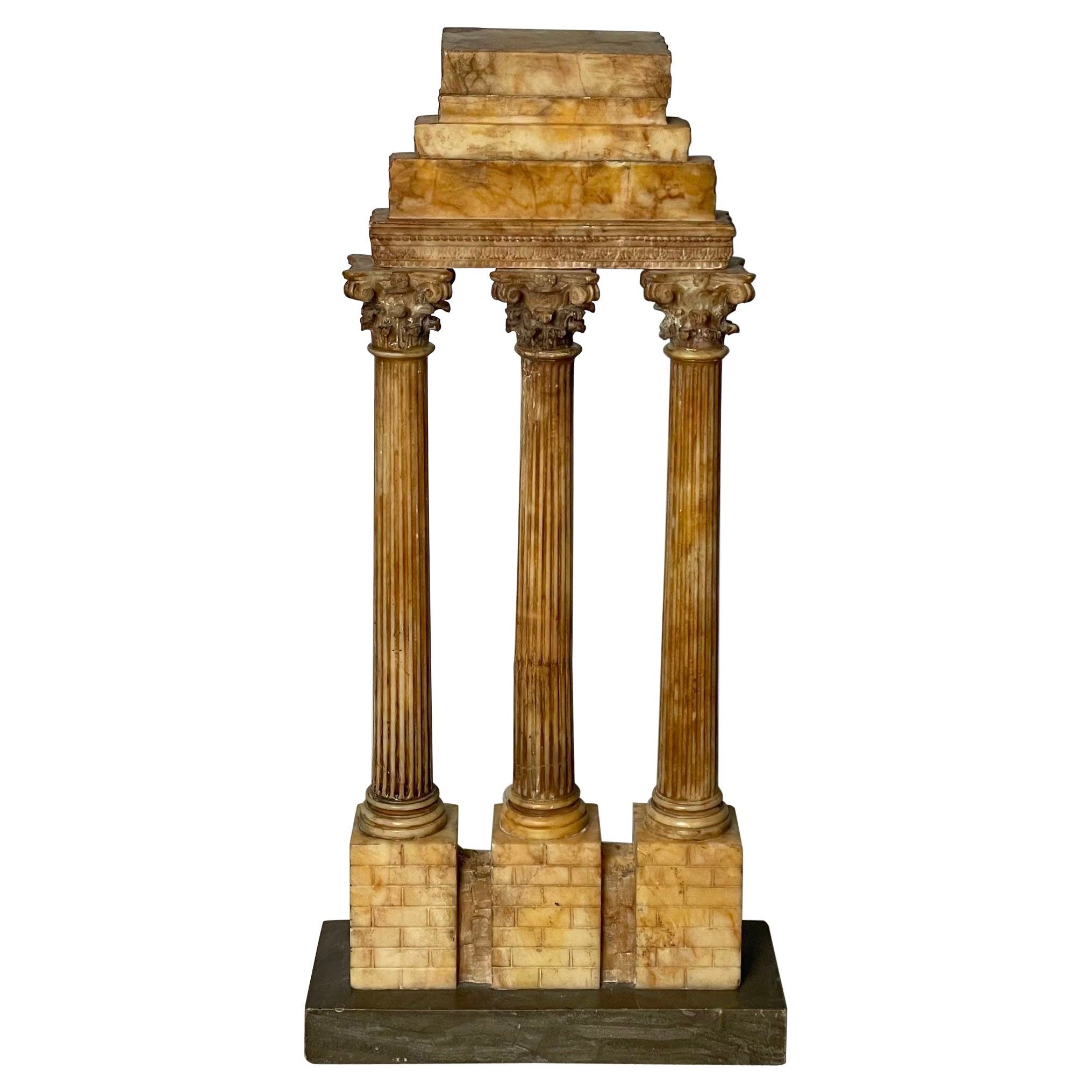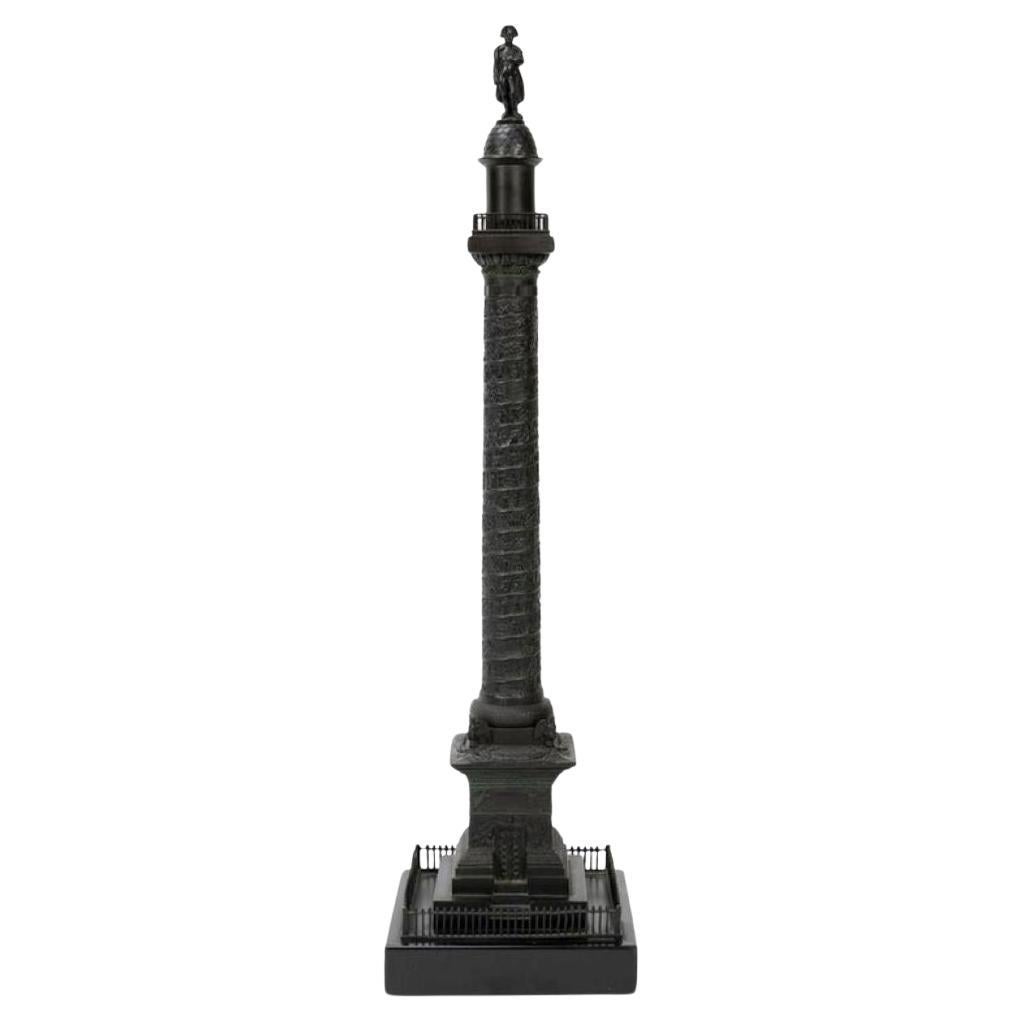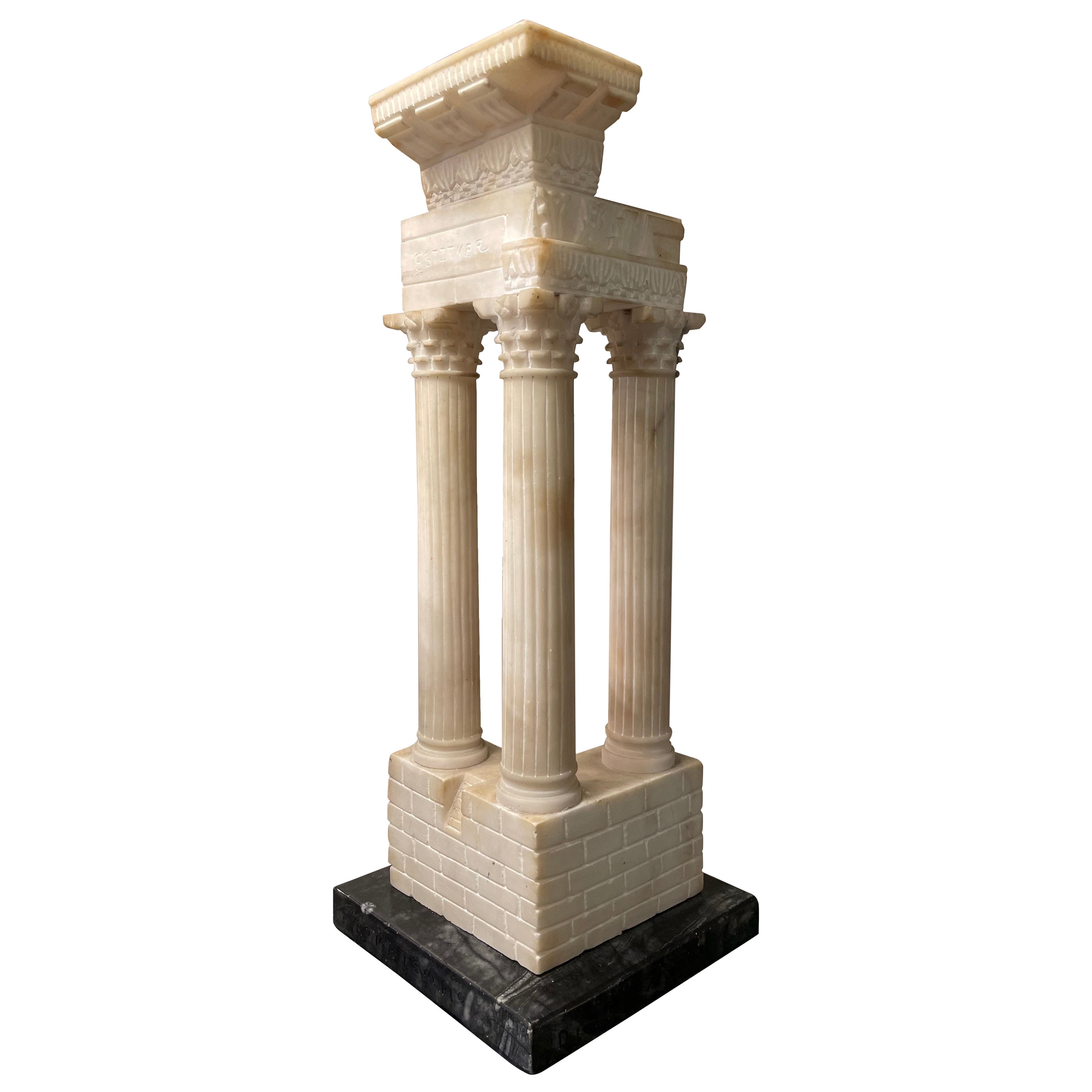Items Similar to A Pair of ‘Grand Tour’ Models of Ruins Celebrating the Corinthian Order
Want more images or videos?
Request additional images or videos from the seller
1 of 7
A Pair of ‘Grand Tour’ Models of Ruins Celebrating the Corinthian Order
About the Item
A Large Pair of Giallo Antico Marble ‘Grand Tour’ Models of Ruins Celebrating the Corinthian Order, Attributed To The Workshop Of Benedetto Boschetti.
The Temple of Castor and Pollux of flat section with three Corinthian columns supporting inverted stepped pediment with dentil cornice. The base modelled with blocks atop a black marble slab.
The Temple of Vespasian and Titus with three corner Corinthian columns supporting a pediment and frieze with part inscription ‘ESTITVER’. The base modelled with blocks atop a black marble slab.
Italy, Circa 1860.
These models of famous Roman ruins of prize monuments of the Corinthian order of architecture are exemplary of the souvenirs of exquisite quality collected by milordi in Italy on their ‘Grand Tour’.
The superior scale and quality of these examples indicate that they are of exhibition quality as evidenced by a very similar set in a photograph of the Italian Court at the International Exhibition in London in 1862. Reproductions of antiquities, sculpture and architectural models, often in coloured marbles, were made throughout Italy, with the famous workshops being those of the Valadier family in Venice, Barzanti in Florence and Boschetti in Rome.
The marble giallo antico was one of the most used marbles of the Roman Empire and was mined at Chemtou in Tunisia, ancient Numidia, and hence it’s also known by the Latin name marmor numidicum.
The Temple of Castor & Pollux
One of the most famous ruins of the Roman Forum are three columns which are all that remain of a temple dedicated to Castor and Pollux, twin half-brothers in Greek and Roman mythology, known together as the Dioscuri. Built in their honour on the spot where, according to legend, Castor and Pollux appeared as two able horsemen to aid the infant Roman Republic in battle against the last King of Rome. Dedicated on the ides of July 484 BC the temple served as a meeting place for the Roman senate and was variously destroyed by fire and rebuilt. The remaining three columns date to the rebuilding by the emperor Tiberius in 6 AD. Already falling down by the 4th century, the temple was closed during the persecution of the pagans in the late Roman Empire, and little is known of its history until the 15th century when only three columns were standing as evidenced by the street running past them being called via Trium Columnarum. By the mid-18th century with the columns at risk of collapse scaffolding was erected for repairs which allowed Piranesi and the young English architect George Dance the Younger to climb up and take accurate measurements. The cause of the Conservatori was promoted by the ensuing production of drawings, engravings and models. Dance wrote “I believe you won't be displeased to see a model cast from the finest example of the corinthian order perhaps in the whole world” (Letter of the 4 October 1760 in J. Lever, Catalogue of the Drawings of George Dance, 2004, p. 64).
The Temple of Vespasian and Titus
Dedicated in 79 AD to the emperors of the Flavian dynasty Vespasian and Titus, it was a classical prostyle hexastyle temple meaning it has a portico with a row of columns. It is situated between the Temple of Concord and the Portico of the Dei Consentes, something of a tight spot in the Roman Forum. The temple is built on a podium and with Corinthian Columns standing over fifteen meters high, six to the front and two to the sides of which all that survives today are three Corinthian columns at the portico’s Southeast corner. The entablature is sculpted with sacrificial implements and although the inscription survives only in unreadable parts we know from a transcription made in the 8th century that it read “Divo Vespasiano Augusto S P Q R Impp. Caess. Severus et Antoninus Pii Felices Augg. Restituer”. The 'ESTITVER' visible being ‘[r]estituer(unt)’ ‘they restored’. The Severan emperors’ restoration of the temple was quite limited, because the capitals and the entablature remain in the Flavian style. The curious arrangement of the temple steps within the colonnade, as visible on this model, accommodate the limited space of the site and were restored by Giuseppe Valadier in 1811.
Dimensions:
Temple of Castor and Pollux, 84 cm high; 39 cm wide; 15 cm deep
Temple of Vespasian and Titus, 81 cm high; 25 cm wide; 27 cm deep
The workshop of Benedetto Boschetti (1820-1870) was renowned for the exceptional quality of its marble work 'after the antique'. From his premises at 74 via Condotti in Rome, Boschetti supplied extremely high quality works of art to satisfy the academic and sophisticated tastes of young Englishmen on the Grand Tour.
His work was widely praised and he was awarded a medal at the Great Exhibition of 1851 in London. The most celebrated examples of his work today are a mosaic table depicting the Triumph of Cupid in the Gilbert Collection, London, and the fine reductions of the Warwick Vase, in rosso antico now in the Toledo Museum, Ohio.
Bibliography:
Gonzalez-Palacios, Alvar, 'Il tiempo del gusto', Longanesi (Milan), 1986.
Meyer, Jonathan, 'Great Exhibitions: London, New York, Paris, Philadelphia, 1851-1900', Antique Collector's Club (Woodbridge, UK), 2006; p.41
- Attributed to:Benedetto Boschetti (Sculptor)
- Dimensions:Height: 33.08 in (84 cm)Width: 15.36 in (39 cm)Depth: 5.91 in (15 cm)
- Style:Grand Tour (Of the Period)
- Materials and Techniques:
- Place of Origin:
- Period:
- Date of Manufacture:Circa 1860
- Condition:Wear consistent with age and use.
- Seller Location:Brighton, GB
- Reference Number:
About the Seller
5.0
Recognized Seller
These prestigious sellers are industry leaders and represent the highest echelon for item quality and design.
Platinum Seller
These expertly vetted sellers are 1stDibs' most experienced sellers and are rated highest by our customers.
Established in 1964
1stDibs seller since 2014
48 sales on 1stDibs
Typical response time: 1 hour
Associations
The British Antique Dealers' AssociationLAPADA - The Association of Arts & Antiques Dealers
- ShippingRetrieving quote...Ships From: Brighton, United Kingdom
- Return PolicyA return for this item may be initiated within 7 days of delivery.
More From This SellerView All
- Louis XVI Style GBaby Grand Piano by Gaveau à ParisBy GaveauLocated in Brighton, West SussexA fine Louis XVI style gilt-bronze mounted baby grand Piano by Gaveau à Paris. Serial number 67874. This fine baby grand piano has a quarter-veneered top with a stiff leaf cas...Category
Vintage 1910s French Louis XVI Musical Instruments
MaterialsOrmolu
- Louis XVI Serinette in the Form of a Miniature Commode by Richard, Paris, 1775Located in Brighton, West SussexA very rare Louis XVI period serinette or bird organ in the form of a transitional style gilt bronze mounted and marquetry inlaid miniature commode in the manner of gilbert, by Robert Richard, Paris. With a label for ' RICHARD - maitre facteur d’orgues et mécanicien / Rue de richelieu à la bibliothèque Du Roy / Paris 1775'. This rare Serinette or Bird Organ has a wooden cylinder barrel mounted by twelve pins and linked to twelve sound pipes. A crank attached to the front panel controls the bellows that activates the mechanism. The exceptional marquetry inlaid case is in the form of a gilt bronze mounted transitional style miniature commode. The top of the commode is inlaid with a landscape scene with buildings, opening to an interior with an allegory of Love Conquering All, represented by two doves perching on a bow and quiver. The front of the commode depicts two obelisks centred by a Fine musical trophy and each side is inlaid with panels depicting the Medici Vase. The back of the commode is decorated with floral marquetry. A closely related Serinette dating from circa 1770, also in the form of a miniature commode, with the marquetry case stamped by the master marqueteur Leonard Boudin, is in the collection of the Victoria & Albert Museum, London. The term serinette is derived from serine, French for finch. The instrument worked like a small barrel organ with a barbed cylinder, wind box and lead pipes and produced a high, thin sound in imitation of birds. Other versions included a merline, which copied blackbirds and a turlutaine, which copied curlews. Used to teach caged birds to sing tunes, different barrels could be inserted to train different birds. It first appeared in France circa 1730 and became a popular drawing-room toy for fashionable women. An interesting painting commissioned in 1751 for Louis XV by Jean-Baptiste-Siméon Chardin and now in the collection of the Louvre, depicts a refined lady seated in her salon playing a bird organ to encourage her bird to sing. Robert Richard Robert Richard was a Parisian organ and harpsichord maker and the mécanicien du roi to Louis XV and Louis XVI and was based in the Bibliothèque du Roi in rue de Richelieu. Initially working alongside the Cliquot family who acted as 'facteur d'orgue du Roi', he is recorded as building an organ for the church of Notre-Dame de Quebec, in Montreal in 1753 (destroyed in 1759) and as the inventor of a mechanical concert shown in an engraving by d'Eisen in 1769. Canon Jean Marie De La Corne described Robert Richard as : ''Le plus habile ouvrier de paris, fameux mechanitien et Homme de probité''. French, Dated 1775. Literature: Pierre Kjellberg, The French Furniture of the 17th century, The Editions of the Amateur, 2008 Count Francois de Salverte, Cabinetmakers of the 18th century, Editions of Art and History, 1934 Raymond Russell, Victoria and Albert Museum Catalogue of Musical Instruments, Volume I - Keyboard Instruments,(London, 1968; p. 69.) Elizabeth Miller...Category
Antique Mid-18th Century French Louis XVI Musical Instruments
MaterialsWood
- Pair of Patinated Bronze Models of the Townley Vase Cast by DelafontaineBy AUGUST MAXIMILIEN DELAFONTAINELocated in Brighton, West SussexA fine pair of patinated bronze models of the townley vase, cast after the antique, by Auguste-Maximilien Delafontaine. The bronze stamped to the under...Category
Antique 19th Century French Classical Roman Vases
MaterialsBronze
- ‘Les Grands Faunes’, a Pair of Candelabra after François Rémond, circa 1880By François RémondLocated in Brighton, West Sussex‘Les Grands Faunes’, a large and very finely cast pair of gilt bronze and patinated bronze figural candelabra on green granite marble bases, after a model by François Rémond...Category
Antique Late 19th Century French Louis XV Candelabras
MaterialsBronze
- A Regence Style Grand Cartel de Applique In the Manner of André-Charles BoulleBy André-Charles BoulleLocated in Brighton, West SussexA Regence Style Gilt-Bronze and Boulle Marquetry Inlaid Grand Cartel de Applique, In the Manner of André-Charles Boulle. The eight-day twin-train movement, striking on a bell. The dial with a porcelain cartouche inscribed ‘Thuret a Paris’. The movement stamped Etienne Maxant and ‘12775: 8.1 EM’. This impressive and large cartel clock has a circular, arabesque chased, brass dial with Roman numerals on enamelled cartouches, with engraved Arabic seconds and polished steel hands. The dial sits within a waisted case, with large acanthus mounted gilt-bronze volutes...Category
Antique 19th Century French Wall Clocks
MaterialsBronze
- Pair of Bronze Models of a Standing Bull and a Running Cow, circa 1890By Isidore Jules Bonheur, Francois Auguste Hippolyte Peyrol 1Located in Brighton, West SussexA pair of large and finely patinated bronze models of a standing bull and a running cow after models by Isidor-Jules Bonheur, Cast on a Naturalistic Base. French, circa 1890. Signed 'I BONHEUR' and stamped 'PEYROL EDITEUR'. Bonheur was a regular exhibitor at the Paris Salon and his naturalistic depiction of farm animals, including cattle, was one of his most popular subjects. The bronze was cast by his brother-in-law, Hippolyte Peyrol, who ran one of the most successful art foundries in Paris at this time. Isidore-Jules Bonheur (1827-1901) was the son of the painter Raymond Bonheur and younger brother of Rosa Bonheur, the famous sculptor. He was born in Bordeaux and studied painting, at first with his father and then with the Ecole des Beaux Arts in Paris, moving on to sculpture in 1848. He made his debut at the Paris Salon in 1848 with a painting and plaster study of the same subject ‘African horseman attacked by a lioness’. From then onwards, Bonheur exhibited regularly at the Salon as well as other exhibitions, winning medals in 1865 and 1869 together with the prized Gold Medal at the Exposition Universelle of 1889. He was awarded the Legion d’Honneur in 1895. Most of Bonheur’s casts were by his uncle by marriage, Hippolyte Peyrol, whose tiny foundry mark is often very difficult to find. Bonheur’s studies range from farm animals, bears and tigers in a very naturalistic vein to equestrian groups. Although noted primarily for his small groups he did complete two large scale commissions, one to his sister Rosa, at Fontainbleau and the other, two stone lions at the steps of the Royal...Category
Antique Late 19th Century French Animal Sculptures
MaterialsBronze
You May Also Like
- Pair Rouge Marble ‘Grand Tour’ Models of Ruins Celebrating the Corinthian OrderBy Benedetto BoschettiLocated in New York, NYA Large and Incredible Pair of Rouge Marble ‘Grand Tour’ Models of Ruins Celebrating the Corinthian Order, Most Probably Attributed To The Workshop Of Benedetto Boschetti. The fist ...Category
Antique 1860s Italian Grand Tour Models and Miniatures
MaterialsMarble
- Pair of Giltwood Architectural Corinthian Columns in Grand Tour StyleLocated in Nashville, TNA nicely carved pair of 19th century Grand Tour period giltwood souvenirs of fluted columns with Corinthian capitals.Now mounted on contemporary acrylic bases with a back channel for...Category
Antique Early 19th Century Italian Grand Tour Architectural Models
MaterialsGiltwood
- Diminutive Italian Grand Tour Model of Ruins, Sienna Marble, Statue / SculptureLocated in Stamford, CTItalian Grand Tour Corinthian Style Stone / Marble Model of Ruins, Sienna Marble, Statue / Sculpture. Grand Tour Giallo Antico Marble Model of the Temple of Castor & Pollux. A very fine and early Roman neoclassical period grand tour Sienna...Category
Antique 1890s Italian Baroque Architectural Models
MaterialsMarble, Breccia Marble
- Grand Tour Model of the Eiffel Tower, Now as a LampLocated in West Palm Beach, FLGrand Tour model of the Eiffel Tower, now as a lamp, newly wired. The architectural model stands 30" high, 33" high to the top of the socket.Category
Early 20th Century French Grand Tour Table Lamps
MaterialsWrought Iron
- Large Grand Tour Bronze Model of the Place Vendôme, With NapoleonLocated in West Palm Beach, FLLarge Grand Tour Bronze Model of the Place Vendôme, With Napoleon France, circa 1870s This exceptional Grand Tour bronze model of the Place Vendôme, dating back to the 1870s in France, is a magnificent tribute to history and artistry. Standing at an impressive height of 26 inches and mounted on a 6.75-inch square Belgian Black Marble base with a bronze fence...Category
Antique 19th Century French Grand Tour Architectural Models
MaterialsBelgian Black Marble, Bronze
- Italian Grand Tour Alabaster Model the Roman Forum Temple of VespasianLocated in Stamford, CTItalian Grand Tour model of the ancient Temple of Vespasian located in the Roman Forum, Rome. Carved from alabaster, this is a handsome example of a souvenir carving which would have been collected by a European or American sophisticate making a Grand Tour of the ancient sites of Italy. This wonderful architectural miniature is evocative of another time and place. Roma Templo Di Vespasiano' etched into the black marble base. It has been drilled to be wired, not the first time I have owned one of these that had been mounted as a lamp. The Temple of Vespasian and Titus is located in Rome at the western end of the Roman Forum between the Temple of Concordia and the Temple of Saturn...Category
Early 20th Century Italian Grand Tour Architectural Models
MaterialsAlabaster, Marble
